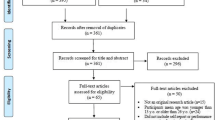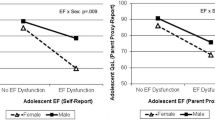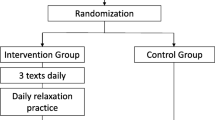Abstract
The aim of the present review was to examine and report findings from published research to date that has examined associations between executive function (EF), adherence, and glycemic control in youth with type 1 diabetes. A review of the published research is presented with the objectives of reporting the following: (1) the associations between EF and adherence, (2) the associations between EF and glycemic control, (3) proposed methodological considerations needed to advance related research, (4) recommendations for future research, and (5) clinical recommendations. The major conclusions of this review support the presence of an association between EF, adherence, and glycemic control. Additional prospective and controlled studies are necessary to fully understand the impact of EF on the ability of youth to independently manage type 1 diabetes.

Similar content being viewed by others
References
Papers of particular interest, published recently, have been highlighted as: • Of importance •• Of major importance
Bagner DM, Williams LB, Geffken GR, Silverstein JH, Storch EA. Type 1 diabetes in youth: the relationship between adherence and executive functioning. Child Health Care. 2007;36:169–79.
Danne T, Mortensen HB, Hougaard P, Lynggaard H, Aanstoot HJ, Chiarelli F, et al. Persistent differences among centers over 3 years in glycemic control and hypoglycemia in a study of 3,805 children and adolescents with type 1 diabetes from the Hvidøre Study Group. Diabetes Care. 2001;24:1342–7.
Hansen CL, Henggler SW, Harris MA, Cigrang JA, Schinkel AM, Rodrigue JR, et al. Contributions of sibling relations to the adaptation of youths with insulin dependent diabetes mellitus. J Consult Clin Psychol. 1992;60:104–12.
La Greca AM, Auslander WF, Greco P, Spetter D, Fisher Jr EB, Santiago JV. I get by with a little help from my family and friends: adolescents’ support for diabetes care. J Pediatr Psychol. 2005;20:449–76.
Weissberg-Benchell J, Glasgow AM, Tynan WD, Wirz P, Turek J, Ward J. Adolescent diabetes management and mismanagement. Diabetes Care. 1995;18:177–82.
Wysocki T, Hough BS, Ward KM, Green LB. Diabetes mellitus in the transition to adulthood: adjustment, self-care, and health status. J Dev Behav Pediatr. 1992;13:194–201.
American Diabetes Association. Standards of medical care for patients with diabetes mellitus. Diabetes Care. 2003;26:S33–50.
Hood KK, Peterson CM, Rohan JM, Drotar D. Association between adherence and glycemiccontrol in pediatric type 1 diabetes: a meta-analysis. Pediatrics. 2009;124:e1171–8.
Lehto JE, Juujärvi P, Kooistra L, Pulkkinen L. Dimensions of executive functioning: evidence from children. Brit J Dev Psychol. 2010;21:59–80.
Baddeley A. Exploring the central executive. Q J Exp Psychol. 1996;49A:5–28.
Barkley RA. Additional evidence supporting the existence of the executive functions. In: Barkley RA, editor. ADHD and the nature of self-control. New York: The Guildford Press; 1997.
Lezak MD. Neuropsychological assessment. New York: Oxford University Press; 1995.
Zelazo PD, Carter A, Reznick J, Frye D. Early development of executive function: a problem-solving framework. Rev Gen Psychol. 1997;1(2):198–226.
Anderson PJ. Towards a developmental model of executive function. In: Anderson V, Jacobs R, Anderson PJ, editors. Executive functions and the frontal lobes. New York, NY: Taylor & Francis Publishers; 2008. p. 3–21.
Stuss DT, Benson D. Neuropsychological studies of the frontal lobes. Psychol Bull. 1984;95:3–28.
Gioia GA, Isquith PK, Guy SC, Kenworthy L. The behavior rating inventory of executive functioning. Lutz, FL: Psychological Assessment Resources; 2000.
Zelazo PD, Carlson SM. Hot and cool executive function in childhood and adolescence: development and plasticity. Child Dev Perspect. 2012;6(4):354–60.
Damasio A, Grabowski T, Frank R, Galaburda A, Damasio H. The return of Phineas Gage: clues about the brain from the skull of the famous patient. Science. 1994;264:1102–5.
Stuss DT, Alexander M. Executive functions and the frontal lobes: a conceptual view. Psychol Res. 2000;63:289–98.
Stuss DT, Alexander MP, Floden D, Binns MA, Levine B, McIntosh AR, et al. Fractionation and localization of distinct frontal lobe processes: evidence from focal lesions in humans. In: Stuss DT, Knight RT, editors. Principles of frontal lobe function. New York: Oxford University Press; 2002.
Gratten L, Eslinger PJ. Frontal lobe damage in children and adults: a comparative review. Dev Neuropsychol. 1991;7(3):283–326.
Baker S, Rogers R, Owen A, Frith C, Dolan R, Frackowiak R, et al. Neural systems engaged by planning: a PET study of the tower of London task. Neuropsychologia. 1996;34(6):515–26.
Fuster JM. Frontal lobes. Curr Opin Neurobiol. 1993;3:160–5.
Dela Sala S, Gray C, Spinnler H, Trivelli C. Frontal lobe functioning in man: the riddle revised. Arch Clin Neuropsychol. 1998;13(8):663–82.
Barnea-Goraly N, Menon V, Eckert M, Tamm L, Bammer R, Karchemskiy A. White matter development during childhood and adolescence: a cross sectional diffusion tensor imaging study. Cereb Cortex. 2005;15:1848–54.
Gogtay N, Giedd J, Lusk L, Hayisha K, Greenstein D, Vaituzis C, et al. Dynamic mapping of human cortical development during childhood and early adulthood. Proc Natl Acad Sci U S A. 2004;101:8174–9.
Sowell E, Thompson P, Welcome S, Henhenious A, Toga A, Petersen B. Cortical abnormalities in children and adolescents with attention-deficit/hyperactivity disorder. Lancet. 2003;362:1699–707.
Anderson V. Assessment of executive function in children: an introduction. Child Neuropsychol. 2002;8:319–49.
De Luca CR, Leventer RJ. Developmental trajectories of executive functions across the lifespan. In: Anderson V, Jacobs R, Anderson PJ, editors. Executive functions and the frontal lobes. New York, NY: Taylor & Francis Publishers; 2008. p. 23–56.
Gogtay N, Sporn A, Clasen LS, Nugen TE, Greenstien D, Nicholson R, et al. Comparison of progressive gray matter loss in childhood onset schizophrenia with that in childhood-onset atypical psychoses. Arch Gen Psychiatr. 2004;61:17–22.
Anderson V, Anderson P, Northam E, Jacobs R, Catroppa C. Development of executive functions through late childhood and adolescence in an Australian sample. Dev Neuropsychol. 2001;20:385–406.
Benes FM, Turtle M, Farol P. Myelination of a key relay zone on the hippocampal formation occurs in the human brain during childhood, adolescence, and adulthood. Arch Gen Psychiatr. 1994;51:477–84.
Sowell E, Delis D, Stiles J, Jernigan T. Improved memory functioning and frontal lobe maturation between childhood and adolescence: a structural MR study. J Int Neuropsychol Soc. 2001;7:312–22.
Arnett JJ. Emerging adulthood: a theory of development from the late teens through the twenties. Am Psychol. 2000;55:469–80.
Barkley RA, Edwards G, Laneri M, Fletcher K, Metevia L. Executive functioning, temporal discounting, and sense of time in adolescents with attention deficit hyperactivity disorder and oppositional defiant disorder. J Abnorm Child Psychol. 2009;29(6):541–56.
Nigg JT, Blaskey L, Huang-Pollock C, Rappley MD. Neuropsychological executive functions and ADHD DSM-IV subtypes. J Am Acad Child Psychol. 2002;41:59–66.
Willcutt EG, Doyle AE, Nigg JT, Faraone SV, Pennington BF. Validity of the executive function theory of attention-deficit/hyperactivity disorder: a meta-analytic review. Biol Psychiatr. 2005;57(11):1336–46.
Denckla MB. Measurement of executive functioning. In: Lyon GR, editor. Frames of reference for the assessment of learning disabilities: new views on measurement issues. Baltimore: Paul H. Brookes Publishing Company; 1994. p. 117–42.
Castaneda AE, Tuulio-Henriksson A, Marttunen M, Suvisaari J, Lonnqvist J. A review on cognitive impairments in depressive and anxiety disorders with a focus on young adults. J Affect Dis. 2008;106:1–27.
Emerson CS, Mollet GH, Harrison DW. Anxious-depression in boys: an evaluation of executive functioning. Arch Clin Neuropsychol. 2005;20:539–46.
Channon S, Pratt P, Robertson MM. Executive function, memory, and learning in Tourette’s syndrome. Neuropsychology. 2003;17:247–54.
Ozonoff S, Jensen J. Specific executive function profiles in three neurodevelopmental disorders. J Autism Dev Disord. 1999;29:171–7.
Ozonoff S, Pennington BF, Rogers SJ. Executive function deficits in high functioning autistic individuals: relationship to theory of mind. J Child Psychol Psychiatry. 1991;32:1081–105.
Luciano M, Wright MJ, Smith GA, Geffen GM, Geffen LB, Martin NG. Genetic covariance among measures of information processing speed, working memory, and IQ. Behav Genet. 2001;31:581–92.
Miyake A, Friedman NP, Emerson MJ, Witzki AH, Howerter A, Wager TD. The unity and diversity of executive functions and their contributions to complex “frontal lobe” tasks: a latent variable analysis. Cogn Psychol. 2000;41:49–100.
Miyake A, Friedman NP, Rettinger DA, Shah P, Hegarty M. How are visuospatial working memory, executive functioning, and spatial abilities related? A latent variable analysis. J Exp Psychol Gen. 2001;13:621–40.
Friedman NP, Miyake A, Corley RP, Young SE, DeFries JC, Hewitt JK. Not all executive functions are related to intelligence. Psychol Sci. 2006;17(2):172–9.
Nadebaum C, Anderson V, Catroppa C. Executive function outcomes following traumatic brain injury in young children: a five year follow-up. Dev Neuropsychol. 2007;32:703–28.
Memisevic H, Sinanovic O. Executive function in children with intellectual disability - the effects of sex, level and aetiology of intellectual disability. J Intell Disabil Res. 2013. doi:10.1111/jir.12098.
Cohen J. Statistical power analysis for the behavioral sciences (second ed.). Lawrence Erlbaum Associates. 1988.
Cohen J. A power primer. Psychol Bull. 1992;112(1):155–9. doi:10.1037/0033-2909.112.1.155.
Rosenthal R. Parametric measures of effect size. In H. Cooper & L. V. Hedges (eds.), The Handbook of Research Synthesis. New York, NY: Sage. 1994;239.
McNally K, Rohan J, Pendley J, Delamater A, Drotar D. Executive functioning, treatment adherence, and glycemic control in children with type 1 diabetes. Diabetes Care. 2010;33:1150–62.
Graziano PA, Geffken GR, Williams LB, Lewin AB, Duke DC, Storch EA, et al. Gender differences in the relationship between parental report of self-regulation skills and adolescents’ management of type 1 diabetes. Pediatr Diabetes. 2011;12:410–8. doi:10.1111/j.1399-5448.2010.00692.x.
Smith LB, Kugler BB, Lewin AB, Duke DC, Storch EA, Geffken GR. Executive functioning, parenting stress, and family factors as predictors of diabetes management in pediatric patients with type 1 diabetes using intensive regimens. Child Health Care. 2014. doi:10.1080/02739615.2013.839383. Pre-published online.
Duke DC, Raymond JK, Harris M. The Diabetes Related Executive Functioning Scale (DREFS): pilot results. Child Health Care (Pre-published online). 2014. doi:10.1080/02739615.2013.870040. This publication introduces a measure of diabetes specific executive function with increased sensitivity to assess executive function in youth with type 1 diabetes.
Miller MM, Rohan JM, Delamater A, Shroff-Pendley J, Dolans LM, Reeves G, et al. Changes in executive functioning and self-management in adolescents with type 1 diabetes: a growth curve analysis. J Pediatr Psychol. 2013;38:18–29. This publication examined EF using a longitudinal approach. An nice exemplar of a longitudinal approach needed to examine type 1 diabetes and executive function.
Harris MA, Wysocki T, Sadler M, Wilkinson K, Harvey LM, Buckloh LM, et al. Validation of a structured interview for the assessment of diabetes self-management. Diabetes Care. 2000;23:1301–3. doi:10.2337/diacare.23.9.1301.
Harris MA, Duke DC, Raymond JK, Harris JB, Shimomaeda L, Shimomaeda K. Self-Administered Diabetes Self-Management Profile (SA-DSMP): reliability, validity, and utility. Diabetes [Abstract]. 2013;73:2504PO. This publication provides further and updated validation of the DSMP, a well-established measure of adherence in youth with type 1 diabetes.
McNabb W, Quinn M, Murphy D, Thorp F, Cook S. Increasing children’s responsibility for self-care: the in-control study. Diabetes Educ. 1994;20:121–4.
Hood KK, Butler DA, Anderson BJ, Laffel LM. Updated and revised Diabetes Family Conflict Scale. Diabetes Care. 2007;30:1764–9.
Rubin RR, Young-Hyman D, Peyrot M. Parent–child responsibility and conflict in diabetes care (abstract). Diabetes. 1989;38:7A.
Huang C, Hwang C, Wu M, Lin W, Leite W, Wu AW. Diabetes-specific or generic measures for health-related quality of life? Evidence from psychometric validation of the D-39 and SF-36. Value Health. 2008;11:450–61.
Weissberg-Benchell J, Nansel T, Holmbeck G, Chen R, Anderson B, Wysocki T, et al. Generic and diabetes-specific parent–child behaviors and quality of life among youth with type 1 diabetes. J Pediatr Psychol. 2009;34:977–88.
Zelazo PD, Qu L, Muller U. Hot and cool aspects of executive function: relations in early development. In: Schneider W, Schumann-Hengsteler R, Sodian D, editors. Young children’s cognitive development: interrelationships among executive functioning, working memory, verbal ability, and theory of mind. Mahwah, NJ: Lawrence Erlbaum Associates Publishers; 2004. p. 71–93.
Skogli EW, Andersen PN, Hovik KT, Øie M. Development of hot and cold executive function in boys and girls with ADHD: a 2-year longitudinal study. J Atten Disord Published Online. 2014. doi:10.1177/1087054714524984.
Baumeister RF, Schmeichel BJ, Vohs KD. Self-regulation. In: Kruglanski AW, Higgins ET, editors. Social psychology: handbook of basic principles. New York: Guilford Press; 2007. p. 516–39.
Muraven M, Baumeister RF. Self-regulation and depletion of limited resources: does self-control resemble a muscle? Psychol Bull. 2000;126:247–59.
Galliot MT. Unlocking the energy dynamics of executive functioning: linking executive functioning to brain glycogen. Perspect Psychol Sci. 2008;3(4):245–63.
Gailliot MT, Schmeichel BJ, Baumeister RF. Self-regulatory processes defend against the threat of death: effects of self-control depletion and trait self-control on thoughts and fears of dying. J Pers Soc Psychol. 2006;91:49–62.
Gailliot MT, Baumeister RF, DeWall CN, Maner JK, Plant EA, Tice DM, et al. Self-control relies on glucose as a limited energy source: willpower is more than a metaphor. J Pers Soc Psychol. 2007;92:325–36.
Masciampo EJ, Baumeister RF. Toward a physiology of dual-process reasoning and judgment: lemonade, willpower, and expensive rule-based analysis. Psychol Sci. 2008;19:255–60.
Stephens R, Tunney RJ. Role of glucose in chewing gum-related facilitation of cognitive function. Appetite. 2004;43:211–3.
Anderson B, Ho J, Brackett J, Finkelstein D, Laffel L. Parental involvement in diabetes management tasks: relationships to blood glucose monitoring adherence and metabolic control in young adolescents with insulin-dependent diabetes mellitus. J Pediatr Psychol. 1997;130:257–65.
Anderson BJ, Auslander WF, Jung KC, et al. Assessing family sharing of diabetes responsibilities. J Pediatr Psychol. 1990;15:477–92.
Hood KK, Rausch JR, Dolan LM. Depressive symptoms predict change in glycemic control in adolescents with type 1 diabetes: rates, magnitude, and moderators of change. Pediatr Diabetes. 2011;12:718–23.
Hood KK, Butler D, Huestis S, Volkening L, Maher A, Laffel LMB. Depressive symptoms in children and adolescents with type 1 diabetes: association with diabetes-specific characteristics. Diabetes Care. 2006;29(6):1389–91.
Duke DC, Raymond JK, Shimomaeda L, Harris J, Shimomaeda K, Harris M. ADHD plus diabetes equals trouble: diabetes-related executive function in youth. Diabetes [Abstract]. 2013;802-P:A202.
Harris MA, Freeman KA, Duke DC. Transitioning from pediatric to adult health care: dropping off the face of the Earth. Am J Lifestyle Med. 2011;5:85–91.
Weissberg-Benchell J, Wolpert H, Anderson BJ. Transitioning from pediatric to adult care: a new approach to the post-adolescent young person with type 1 diabetes. Diabetes Care. 2007;30(10):2441–6.
Compliance with Ethics Guidelines
ᅟ
Conflict of Interest
Danny C. Duke and Michael A. Harris declare that they have no conflict of interest.
Human and Animal Rights and Informed Consent
This article does not contain any studies with human or animal subjects performed by any of the authors.
Author information
Authors and Affiliations
Corresponding author
Additional information
This article is part of the Topical Collection on Psychosocial Aspects
Rights and permissions
About this article
Cite this article
Duke, D.C., Harris, M.A. Executive Function, Adherence, and Glycemic Control in Adolescents with Type 1 Diabetes: a Literature Review. Curr Diab Rep 14, 532 (2014). https://doi.org/10.1007/s11892-014-0532-y
Published:
DOI: https://doi.org/10.1007/s11892-014-0532-y




